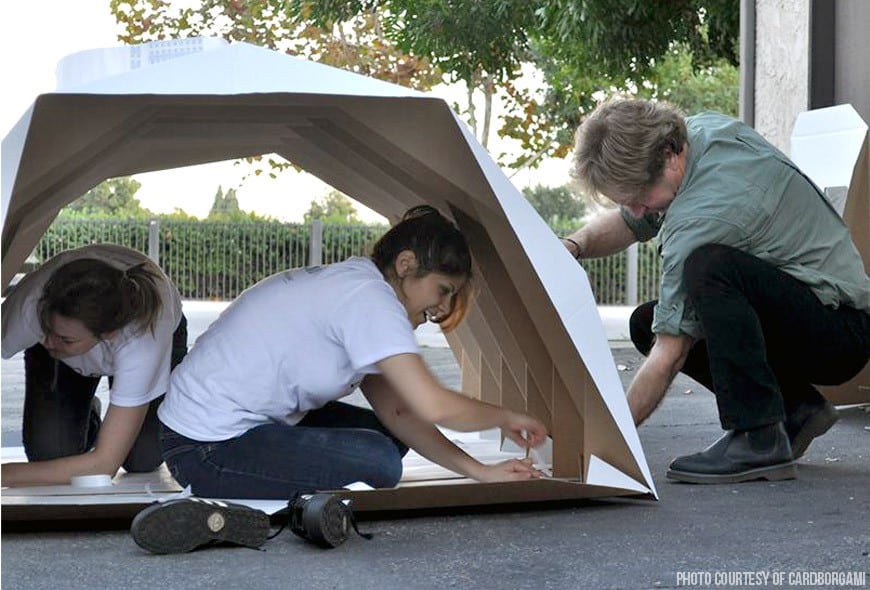In 2013, 610,000 people were reported to be homeless in the U.S. A little less than 10 percent of that total was counted in Los Angeles, which has become second to New York to hold the highest population of transient individuals. While this number may be on a national decline, the amount of people affected is still relatively high.
The US Department of Housing and Urban Development reports each homeless person costs taxpayers an average of $40,000, based on visits to the emergency room, shelters, and jail. But to aid in getting more people off the street, one woman is doing her part to provide temporary relief and create systemic change to solve the problem.
Tina Hovsespian, 28, is the inventor of Cardborigami, a collapsible and portable housing unit designed to be used as a popup shelter for homeless individuals. Incorporating the principles of origami, Hovsepian designed an accordion-esque tent out of corrugated plastic. Once assembled, the unit can collapse and reopen in less than 30 seconds.
The invention of this product recently led her to become recognized by Toyota as their 2015 Mother of Invention and was granted $50,000 to advance her product line. “The overall goal is to develop a new Cardborigami prototype that is more durable and more sustainable so that they can really be implemented in our service pilot program where people actually stay in the shelter,” Hosvepsian tells MiLLENNiAL.
An architecture student from the University of Southern California, Hovsepian was inspired to create Cardborigami after a study abroad trip to South East Asia. There she was redesigning an elementary school and became influenced by the children playing with origami.
When she returned to Los Angeles, it astonished her that homelessness was so rampant and in a decision to take action, created Cardborgami as a solution to the problem. However, this shelter is just her first step in transitioning homeless people off the streets for good.
Steps to Providing a Permanent Home
Hovsepian and her partner Alex Yarijanian have created a model they call “transitionME,” a four-step plan designed to lift people out of homelessness. “Cardborigami’s purpose is to provide temporary shelter with a strong, evidence-based, programmatic backbone to permanently house displaced people,” Yarijanian says.
He tells us, “Step one is immediate response.” This is to get individuals into the Cardborigami shelters and become participants of the transitionME program.
He continues, “Step two connects the participant to services and tools to reintegrate into society.” Most homeless people have access to health services, social skills training, and job training that is being under utilized. Cardorigami plans to help individuals navigate these programs to get the most out of each.
“Step three is permanent housing placement options and step four is designed to help our newly housed participants sustain their housing status through employment within our organization or via partnership,” he concludes. Cardborigami plans to pay program participants $10 an hour to assemble units for mass production. They estimate their target timeframe to get someone off the streets and into a permanent housing unit is 10 months, while their goal is to not exceed 12 months.
Getting Cardborigami into Thousands of Hands
In order to pay for these services, Cardborigami is selling each popup tent for $250. These units can be used for so much more than just homeless shelters, including camping tents, kid forts, and beach structures.
While the price may appear steep, Hovsepian points out, “When someone purchases a shelter they are paying for more than just a shelter. They are also paying for the follow through and the services for filling the gap.”
The non-profit has struggled to get their program implemented into a public pilot program and have met a lot of resistance from officials. Hovsepian says, “I’m really excited to have the support of Toyota and Women in the World because that is going to let people feel a little more comfortable about taking the risk.”
At the end of the day, Cardborigami is trying to empower individuals to take control of their lives while providing a roof over their heads. “The only way to get them on their feet is for them to have an on-going source of income and self-worth that comes from self-empowerment.” Hovsepian adds.
She assures us that Cardborigami has a life beyond just the shelters. “As an architect, I am constantly learning new ways of building and technologies where we can build more efficiently. The end goal of cardborgami is to really build affordable housing units.”
To learn more about Tina Hosvepsian’s role as Toyota’s Mother of Invention or to get involved with Cardborigami visit their website and follow them on Facebook.


